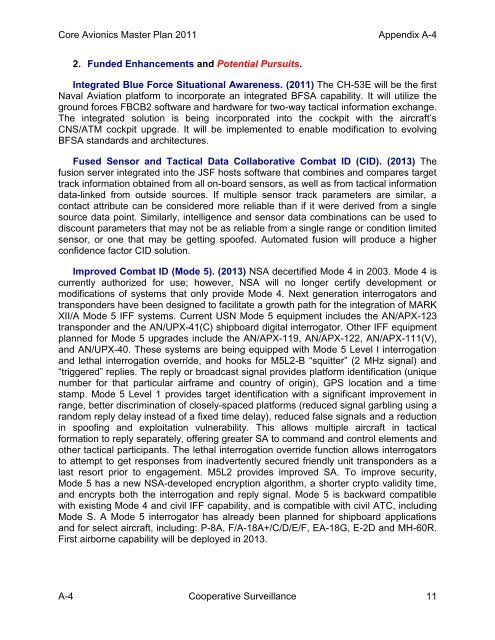Core Avionics Master Plan - NAVAIR - U.S. Navy
Core Avionics Master Plan - NAVAIR - U.S. Navy
Core Avionics Master Plan - NAVAIR - U.S. Navy
- No tags were found...
You also want an ePaper? Increase the reach of your titles
YUMPU automatically turns print PDFs into web optimized ePapers that Google loves.
<strong>Core</strong> <strong>Avionics</strong> <strong>Master</strong> <strong>Plan</strong> 2011 Appendix A-42. Funded Enhancements and Potential Pursuits.Integrated Blue Force Situational Awareness. (2011) The CH-53E will be the firstNaval Aviation platform to incorporate an integrated BFSA capability. It will utilize theground forces FBCB2 software and hardware for two-way tactical information exchange.The integrated solution is being incorporated into the cockpit with the aircraft‟sCNS/ATM cockpit upgrade. It will be implemented to enable modification to evolvingBFSA standards and architectures.Fused Sensor and Tactical Data Collaborative Combat ID (CID). (2013) Thefusion server integrated into the JSF hosts software that combines and compares targettrack information obtained from all on-board sensors, as well as from tactical informationdata-linked from outside sources. If multiple sensor track parameters are similar, acontact attribute can be considered more reliable than if it were derived from a singlesource data point. Similarly, intelligence and sensor data combinations can be used todiscount parameters that may not be as reliable from a single range or condition limitedsensor, or one that may be getting spoofed. Automated fusion will produce a higherconfidence factor CID solution.Improved Combat ID (Mode 5). (2013) NSA decertified Mode 4 in 2003. Mode 4 iscurrently authorized for use; however, NSA will no longer certify development ormodifications of systems that only provide Mode 4. Next generation interrogators andtransponders have been designed to facilitate a growth path for the integration of MARKXII/A Mode 5 IFF systems. Current USN Mode 5 equipment includes the AN/APX-123transponder and the AN/UPX-41(C) shipboard digital interrogator. Other IFF equipmentplanned for Mode 5 upgrades include the AN/APX-119, AN/APX-122, AN/APX-111(V),and AN/UPX-40. These systems are being equipped with Mode 5 Level I interrogationand lethal interrogation override, and hooks for M5L2-B “squitter” (2 MHz signal) and“triggered” replies. The reply or broadcast signal provides platform identification (uniquenumber for that particular airframe and country of origin), GPS location and a timestamp. Mode 5 Level 1 provides target identification with a significant improvement inrange, better discrimination of closely-spaced platforms (reduced signal garbling using arandom reply delay instead of a fixed time delay), reduced false signals and a reductionin spoofing and exploitation vulnerability. This allows multiple aircraft in tacticalformation to reply separately, offering greater SA to command and control elements andother tactical participants. The lethal interrogation override function allows interrogatorsto attempt to get responses from inadvertently secured friendly unit transponders as alast resort prior to engagement. M5L2 provides improved SA. To improve security,Mode 5 has a new NSA-developed encryption algorithm, a shorter crypto validity time,and encrypts both the interrogation and reply signal. Mode 5 is backward compatiblewith existing Mode 4 and civil IFF capability, and is compatible with civil ATC, includingMode S. A Mode 5 interrogator has already been planned for shipboard applicationsand for select aircraft, including: P-8A, F/A-18A+/C/D/E/F, EA-18G, E-2D and MH-60R.First airborne capability will be deployed in 2013.A-4 Cooperative Surveillance 11
















